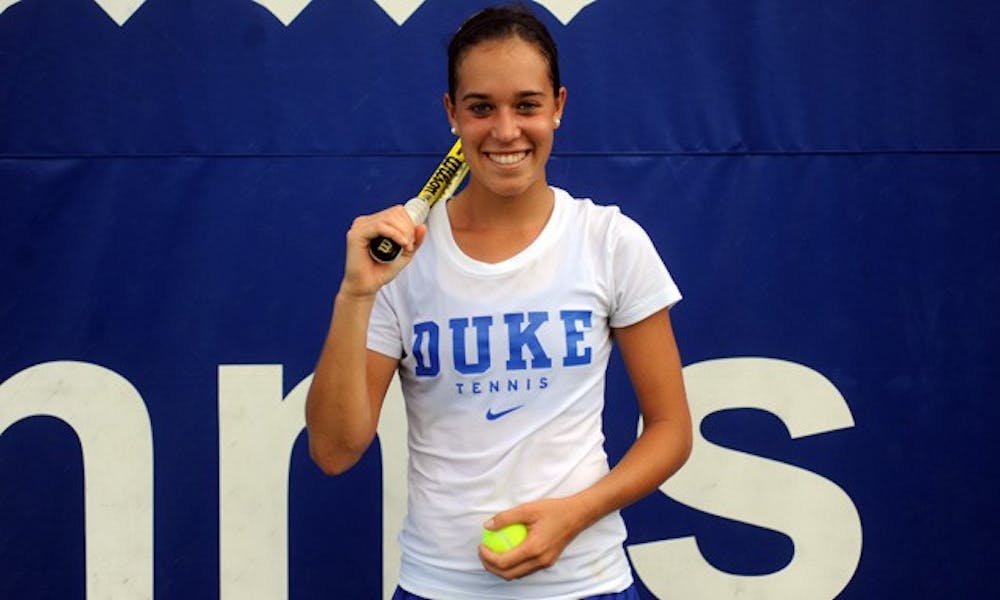There are few athletes that possess the potential to play their sport professionally, and not many of them turn down the big leagues to come to college. Even fewer seek higher education when they’ve already beaten two of the world’s top 100 women’s tennis players. And only one has chosen to attend university after playing in the third round of the U.S. Open.
That unique individual is Beatrice Capra, the highest-ranked player ever to choose collegiate tennis over the professional circuit. That unprecedented decision makes Capra Duke’s new tennis superstar.
Capra began playing tennis when she was eight years old, won her first national tournament six years later and has played on a professional tennis track ever since. In 2010, though, her professional prospects were still uncertain, as she lost at the U.S. junior national tournament. She was preparing to take a few weeks off when she received a phone call from the United States Tennis Association, inviting her to play in a small tournament with a big prize. She did not expect to take home this prize, planning instead to use the tournament as a warm-up for the junior U.S. Open. But she blitzed through the field, and claimed that significant award—a berth at one of the world’s biggest tennis events, the U.S. Open.
The victory in the wild-card qualifier threw her into the national spotlight, but the Maryland native never thought she would have so much success so quickly. Capra had played well at the junior level, but she had yet to prove herself against professional competition. That all changed at the 2010 U.S. Open.
Even one victory was unlikely, but Capra prevailed in the first round, crushing 2004 Wimbledon quarterfinalist Karolina Sprem in straight sets.
“After winning that first round, it gave me confidence knowing that I could compete with all these players,” Capra said. “The whole crowd was for me. It was just really exciting and it really pulled me up.”
Then, she won her second match, trumping eighteenth seed Aravane Rezaï to complete her improbable ascent to the third round against former world No. 1 Maria Sharapova.
Capra, just 18 years old and ranked 371st in world standings, was suddenly the center of attention. The tennis world had been abuzz over the success of American teenager Melanie Oudin, who had skipped college to turn pro, and defeated Sharapova in the second round of the 2009 U.S. Open en route to the quarterfinals. But Oudin had failed to maintain that success, and tennis fans around the nation were ready for another teen idol. With Oudin already out of the 2010 field, Capra fit the bill.
“I remember after winning that [second] match, I went to bed that night and thought, ‘Oh my gosh, is this a dream?’” Capra said. “After that, I was on ESPN, and I got all these interviews. It really didn’t seem like real life at all.”
But the third round was to be the end of Capra’s Cinderella story. Facing one of her own tennis idols in Sharapova proved too intimidating for Capra, and she fell to the Russian 6-0, 6-0.
“I’ll never forget that moment, walking out onto [the court at] Arthur Ashe [Stadium],” Capra said. “I wish I could have done better, but it was amazing.”
Her magical run earned her a significant cash prize, but instead of becoming winnings, the cash turned into the most prize money to be turned down in tennis history. Capra refused the money so she could retain her amateur status.
After doing so well under such a national spotlight, the pressures of proving herself didn’t permit Capra another chance to shine at the U.S. Open. Prior to this year’s Open, she fell in the finals of the wild card tournament to 16-year-old Mackenzie Keys.
In fear of becoming “burnt out” from the professional circuit after starting at such a young age, Capra is excited to play in the structure of college tennis and with a consistent coaching staff.
“When you’re on the pro tour, you can just keep going tournament after tournament and all the matches are going to be tough, so you can lose in the first round,” Capra said. “Whereas in college, you’ll be playing every week against a different team and you’re guaranteed matches. I think, with that respect, it’s just going to allow me to improve.”
Now the Blue Devils have an international tennis star.
As it turns out, Duke was the only school she ever considered attending. She was introduced to the campus when head coach Jamie Ashworth offered up the Sheffield Indoor Tennis Center to the U.S. national team for practice when the team was visiting the area for a tournament.
“Ever since then, I’ve just loved the school,” Capra said. “Duke has always been my top choice. Over the years I kept in contact with Jamie and he’s been so supportive of me. I really think he wants the best for me and he understands my goals. He and [assistant coach] Marc [Spicijaric] and the team—they’re the reason I came here.”
After forsaking the money and fame of turning professional, Capra hopes to set a precedent for future incoming classes of tennis players.
“A lot of the girls think it’s a choice: you either have to go pro or you have to go to college, but you can’t do both,” Capra said. “I think to be able to have an education as well as being a professional athlete is so much better…. I’m trying to start a new trend saying you can come to college and you still accomplish your goals.”
Correction: Beatrice Capra reached the third round of the 2010 U.S. Open, not the quarterfinals, as a previous version stated. The Chronicle regrets the error.
Get The Chronicle straight to your inbox
Signup for our weekly newsletter. Cancel at any time.

